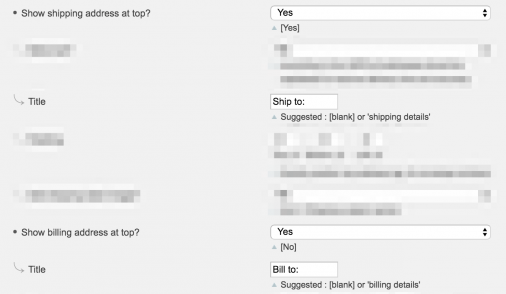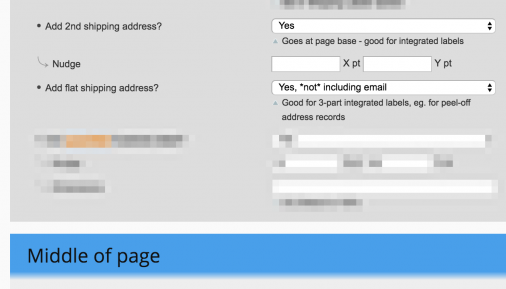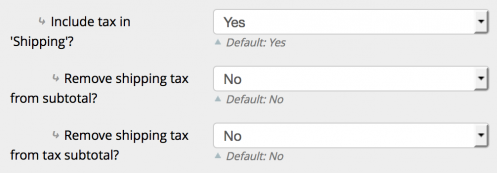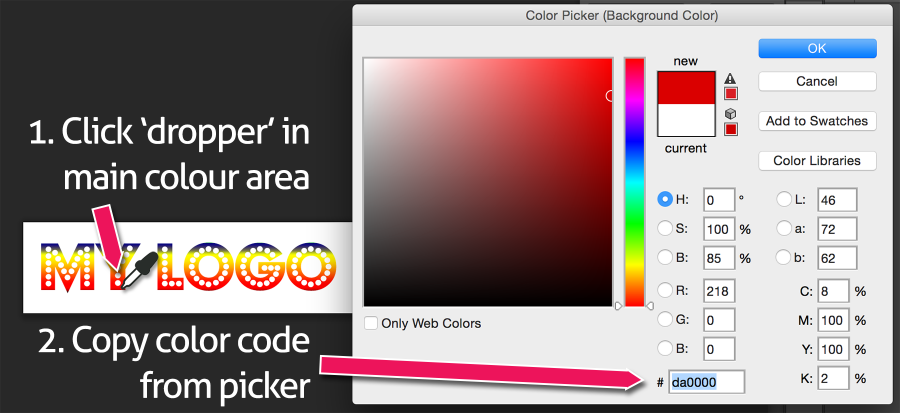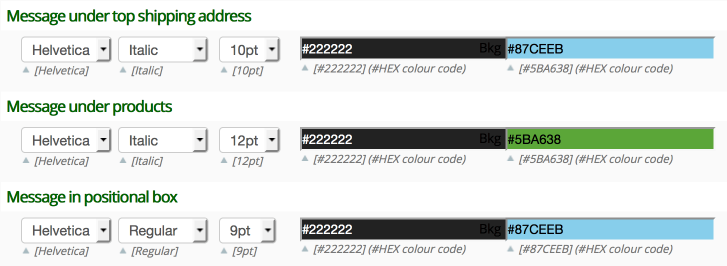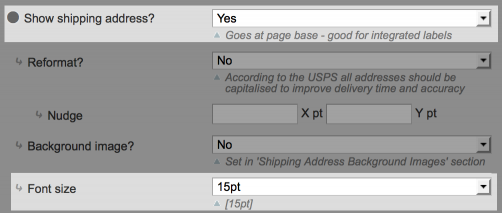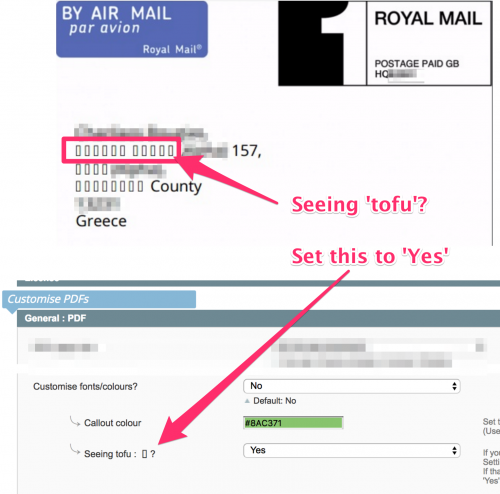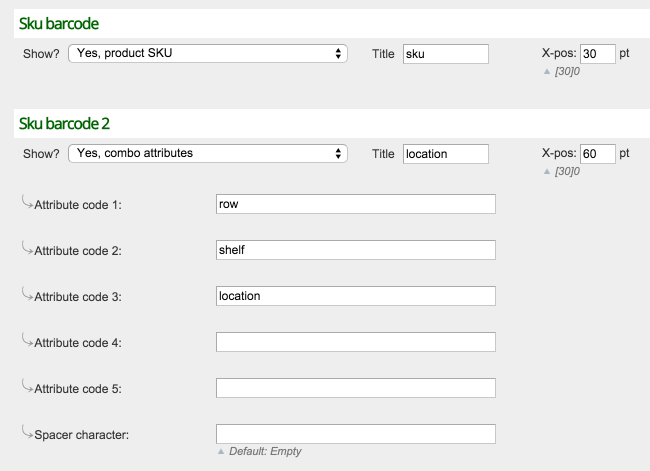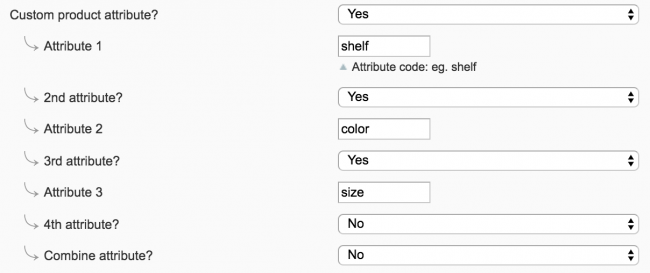Difference between revisions of "pickPack Setup"
m |
m |
||
| Line 472: | Line 472: | ||
: [[File:show-custom-product-options-combined-picklist.png|link=|650px]] | : [[File:show-custom-product-options-combined-picklist.png|link=|650px]] | ||
| + | |||
| + | {{idea|If your warehoused products are stored in a way where each custom option is a different product, you probably want to choose : | ||
| + | : {{menuchoice|Yes, count each option as a separate SKU, grouped under parent product}} | ||
Revision as of 13:06, 28 April 2017
Contents
- 1 Aims & Preparation
- 2 Customising PDF Invoice & Packing Sheet
- 2.1 Nudging Elements Around the PDF
- 2.2 Integrated Labels
- 2.3 Product Images
- 2.4 Custom Product Attributes / Product Options
- 2.5 Bundle Products
- 2.6 SKU
- 2.7 Product Name
- 2.8 Double-line Spacing
- 2.9 Adding Lines Between Products
- 2.10 Shipping Addresses
- 2.11 Show Store-specific Logos/Company Addresses
- 2.12 Editing Tax and Price Display
- 2.13 Customising Quantity Display
- 2.14 Displaying Company VAT/Tax Number
- 2.15 Editing the Packing Sheet & Invoice Titlebars
- 2.16 Add Admin and Customer Comments
- 2.17 Show Gift Messages
- 2.18 Add a Custom Message
- 2.19 Changing Font Size/Colour in PDFs
- 2.20 Français/Deutsch/Español/etc : Translations
- 2.21 Showing 中国/日本の/한국의/русский in PDFs
- 3 Address Labels
- 4 Warehouse/Shipping Printouts
- 5 CSV Exports
- 6 Change Filename Format
Aims & Preparation
Most of this is included if you get the Installation & Setup Service
We're going to get into the meat of pickPack here, and have a quick overview of setting up its options.
We'll also setup exporting order info via csv.
Follow the Easy Install Guide & pickPack: Quickstart to get pickPack up and running.
Customising PDF Invoice & Packing Sheet
The target is customising the pickPack output to suit your unique business.
Set these in SystemConfigMoogento > pickPack > PDF Packing Sheets / PDF Invoices (some of these options can also be set in the Picklist and CSV sections).
Nudging Elements Around the PDF
You'll see a lot of options to 'Nudge' by X and Y. Entering a value into the X field will move that element that distance to the right (or to the left with a negative number) by that distance. Entering a number into the Y field will move an item up (or down with a negative number).
You can print out the results to check how the output matches your integrated labels, but there is an easier way of doing this (than printing multiple copies).
- Scan one printout and open that in Photoshop.
- Make changes in the config, save and output the result.
- Make a screen grab of the full output page, and paste in, with say 30% opacity, into photoshop.
- Line this up with the scanned image (based on a fixed part like the logo, or the top-left of the page), and you can then see the result of your changes without needing to print.
- You can also set the Photoshop measurements on the rulers to points, resize the document to match A4 dimensions, and then use the photoshop measuring tools to get an exact nudge in points to add into the config. That way you can reduce the number of tests needed to about 2 or 3.
Integrated Labels
In the UK and looking for integrated labels? Check out http://www.labelszoo.co.uk/product-category/integrated-labels/
If you're printing addresses on Integrated Labels, this is an important step. If you're not sure what this is, I really recommend having a google, printing orders on integrated labels saved our product business literally hours every week, but more importantly made it a lot more organised - you have everything you need for the order in your hand.
- First up, turn on the shipping address: Add shipping address at bottom? > Yes and have a test print.
- You'll also see Nudge shipping address - you can use this to precisely position the address on your integrated label.
- Other notable sections here:
- Show order ID above address? - useful for when you have packed your orders, you can quickly see which order is which (eg. if the customer requests a last-minute change; or just to quickly work out which orders you have shipped).
- Add Order ID barcode? - you can then automate actions using shipEasy. Eg. as you send each parcel out the door you can set the status to 'shipped', email the customer, and apply a custom tag for the shipment group (all in the time it takes to press the barcode scanning button).
- Add return address at bottom? - if you're making life easy and print the return address in the same integrated sheet, turn this one on.
- You should now have integrated labels printing direct from Magento!
Product Images
Adding product images to the Packing Sheets can look good, it depends on your branding. Adding them to Picklists can help reduce picking mistakes. Turn this on in the config:
- To remove image borders, set the color to #FFFFFF
Custom Product Attributes / Product Options
These two get quite often confused, as they can both be used to represent similar things.
It's probably easier to explain a few typical use-cases, and go from there.
Product Attributes, these are setup in CatalogAttributesManage Attributes section, and then assigned to an Attribute group before they can be set on specific products. Classic examples are things like color, size, condition. Ie. they are specifics of the product.
As these are set one-time per product, you need to make a new product to offer different settings of the attributes.
If you're offering say a model of T-shirt in black or red, then you would usually make a configurable product ('T-Shirt Model A') and simple products for each color (ignoring other options like sizes here). This makes sense for a few big reasons: stock, price, stats. As they are separate unique products, we can 'hold stock' for each simple product (ie. for each unique combination of product attributes). We can easily set and see the price for each, the stock for each.
A product option in this example might be something like '+ Add gold embossing' or '+ Add prewash'. Ie. things which we're not setting specific stock for, and can be added on. You could set 'T-shirt color' as an option, and a few stores do that, but it does make it harder to see (and plan) stock.
In pickPack we can show both the Custom Attributes, and the Product Options. This makes sense - we need to both tell the warehouse guys what to pick, and show (remind?!) the customer what they ordered. pickPack has some very powerful processing for these. If we look at the standard warehouse pick (which may be anything from a huge Amazonian space, to your garage - both will be helped here), we need clear instructions where to go, and what to take. With pickPack we can sort by custom attributes as well.
A standard warehouse shelf layout might be:
- Each row as a letter, A-Z, from the door
- Each shelf as a number, from the bottom
- Along each row, set points marked to show position
with an end shelf attribute looking something like A-2-12 H-8-21 etc.
So if we're pulling and order from A-1-1 and another from Z-10-40, then another from A-1-1 again, this is not going to be very effective!
With pickPack's sorting features, we can output 'Product-Combined PDFs', sorted by shelf, so that we pick orders in an optimal picking pattern. We can show the custom attribute, not only for the shelf, but also for eg. the color, on the sheets.
Custom Product Attributes (eg. Location)
- Show shelving info per product = win for packing efficiency.
- Sort product list by shelving = bonus points (save zig-zagging through the shelves).
- Or show other custom product attributes.
Let's set this up. The procedure is approx the same for all PDFs.
- Find the correct attribute code - if you're not sure, check it in CatalogAttributesManage Attributes
- eg. here our correct code is
shelf(case is important):
- If you haven't saved shelving info for your products yet, you'll need to:
- Create a new attribute and
- Assign it to your product groups, and then
- Save a value for each product to the Catalog.
- Is there an easy way to do that (without editing each product in the Catalog)? Yes!
- eg. here our correct code is
- Find the Custom attributeoption, in the config section for the pickPack PDF that you want to add this to, and set to Yes
- Enter the correct attribute code in the field that shows up, and choose an 'X Pos' (the left-right position of this column in the PDF) to suit your output.
Wanna step to the next level straight away? We can sort products by shelf (or any custom attribute)
Product Options
To show the product options, just find the Show product options? option, and choose how you want them shown.
'Stacked' is probably the most popular one, as is 'Below product line, linear'.
Have a play, see how you go, and choose the method that works best for you.
Bundle Products
pickPack is setup to display Bundles in a few different useful ways.
Hide Bundle Parents or Children
Depending on how you package/sell bundles, you may want to hide either of these. pickPack has options for both:
SKU
Showing the SKU is handy, it's usually what you use to pick the item.
pickPack helps work with whatever way you use SKUs in your warehouse.
You can show the :
- simple product SKU
- (This is be the most often used)
- simple product SKU, with product options
- This will include the auto-added SKU parts, if you're auto-generating custom skus based on selected product options
- parent sku
- (If the product is a configurable child - this may be handy if you sell products mainly by custom product option, where the SKU is auto-generated)
Find the 'Middle of Page' section in the config page (eg. for PDF Invoice).
Product Name
You can change what is shown for the product name in a couple of important ways.
- Show configurable product name instead of simple product name.
- Use this for example to show 'Socks' instead of 'Red Socks Small Women's PCW2849211'.
- Pull the name attribute from the default store, instead of the selling store.
- If your warehouse operates in a different language to your customers this helps to avoid packing mistakes.
- Choose to word-wrap instead of trim a long product name.
- Trimmed usually looks better, but some setups need the full name to pack correctly.

Double-line Spacing
If you frequently ship multi-item orders, and often need to make notes on the Packing Sheet, then double-line spacing can help reduce mistakes.
Just set Double-line spacing? to Yes (Choose between 2x line spacing and a less space-consuming 1.5x).
Adding Lines Between Products
If you frequently ship multi-item orders, and often need to make notes on the Packing Sheet, then double-line spacing can help reduce mistakes.
Just set Packing Sheet Products : Separating Line Color to the color you're after (or set #FFFFFF to remove it).
Shipping Addresses
Customise Format
In General you'll see an important field to set the format of shipping addresses.
- First, set the option Override default address formatting? to Yes. You'll now see a customisable format field.
- Adjust the format to suit.
The default setting should roughly match recommended USPS formatting - you might want to fine-tune it to your local area.

- This is the USA format:
{if company}{company},|{/if}
{if name}{name},|{/if}
{if street}{street},|{/if}
{if city}{city},{/if} {if region}{region}{/if} {if postcode}{postcode}|{/if}
{if country}{country}|{/if}
- This would be a more standard UK format:
{if name}{name},|{/if}
{if company}{company},|{/if}
{if street}{street},|{/if}
{if city}{city},|{/if}
{if region}{region},|{/if}
{if postcode}{postcode}|{/if}
{if country}{country}|{/if}
- If you find your addresses are running too long, probably the best thing is to split up the street lines:
- You can switch {street} for {street1}{street2}{street3}{street4}.
- Just add them into the address format field with 'if' brackets and 'line break pipes' and you're away.
- Eg. here's a typical UK address formatting, with split street lines:
{if company}{company}, {/if company}{if name}{name}|{/if name}
{if street1}{street1}|{/if street1}
{if street2}{street2}|{/if street2}
{if street3}{street3}|{/if street3}
{if street4}{street4}|{/if street4}
{if city}{city}|{/if city}
{if region}{region_full}|{/if region}
{if postcode}{postcode}|{/if postcode}
{if country}{country}|{/if country}
- * If you're trying to change the Zebra Label format, don't forget that section has it's own address formatting field.
Reformat Case and Capitalisation
One of the more annoying things if you're running a tight packing sheet, is to see an address that has been slopping entered by one of your customers!
pickPack has options to override the Case/Capitalisation:
In the PDF Packing Sheets PDF Invoices and PDF Zebra Labels sections in the config, you'll see this option:
You can set this for each specific address - so you can have eg. a shipping label in all-caps, reformat the other address displays to have at least Capital First Letters, or leave it to the customer!
pickPack is fairly intelligent about this, and will always fully-capitalise the zipcode/postcode.
Hide Your Home Country
Let's make international orders easier to see, and filter out your home country from shipping addresses.
- Just enter your country name, as it appears in addresses, and it will be removed. Simpler PDFs!
Change Address Font & Size
This is taken from the Page Body font settings, in General
Bold Last Line
Let's add another little polishing touch, we can bold the last line of the shipping address.
- If you're shipping overseas this can help separate those orders.
- It helps Mr Postman.
- It looks good!
Add 'Ship to' and 'Bill to' titles
Want to show a Billing or Shipping title?
There's an option for that right next to the spot where you enable the addresses:
Add multiple shipping addresses
pickPack allows you to show the shipping address a few times (not only in the top and bottom sections).
This can be useful eg. for peel-off labels as a physical record of shipping each order, marking integrated gift cards with the order details, etc.
- Enable 'bottom shipping address'
- You'll then see 2 options:
- Add 2nd shipping address?
- Add flat shipping address?
- Choose either/both of those
- Move them into position by using the nudge fields
Show Store-specific Logos/Company Addresses
Selling on multiple sales channels? No problem. Yes, you can auto-hide your website eg. from eBay orders (to comply with their TOS) and show it for sales from your own site.
- When editing settings, top left of the config page, look for the Scope dropdown menu:
- Just choose the specific scope you want to change, and wait for it to load, make your changes and save.
- Done!
Editing Tax and Price Display
Show Prices in PDFs
The 'PDF Invoice' should be already set to show pricing, but both this and 'PDF Packing Sheet' can show pricing (or not) as desired. There are many different ways to show these based on your operating country - luckily, pickPack has a range of options to fully customise this!
- First step, set Middle of page > Show Prices to Yes
Change Tax Display Position
- Next up is probably to set how the tax displays. Here's some quick ideas for which method to choose:
Change 'Tax', 'Subtotal', 'Grand Total' Text
- You may want to change how the word 'Tax/VAT' etc. shows for your country. Please edit /app/locale/en_US/Moogento_PickPack.csv (or whatever language you're running on, instead of en_US), and then clear the cache.
Remove (brackets) from the Tax subtotal
- Depending on your local customs, you may want to remove the brackets around the subtotal tax display.
- Set to 'Yes' to show eg. (Tax Incl. $5.55)
- Set to 'No' to show eg. Tax $5.55

Show Tax Breakdown
- Depending on your country and business, you might want to show the breakdown of tax by tax band.
Edit Shipping Tax Display
Depending on how you have your tax setup in Magento, and how you want to show this, you might need to change some settings to show the correct shipping tax amount.
Eg. Some countries include tax in the shipping amount, others don't, some print all tax except shipping separately, etc.
Change How Currencies Display
If you're allow your customers to pay in multiple currencies, you might want to change how the amount paid shows up in Invoices.
eg. if your store is in USD, but you allow your customers to choose a different currency in the store, but pay in USD at the final stage, it may make sense to show both the number they saw on the product page, and the converted equivalent that they paid in checkout, to avoid confusion.
Or, if you allow customers to pay in their own currency, you may want to show your store base currency to keep track at your end how much you're getting once the payment has been converted.
pickPack has a few options, to let you edit both which currency is shown, and how it's shown. You can show both currencies, one currency, and can also change the 'currency symbol' (eg. $) to something more clear if you're dealing with multiple currencies with the same symbol (eg. USD, SGD, HKD).
Yes, you can also show both :) (eg. $SGD).
More options? Sure, you can also turn off all currency symbols.
You'll find this option in the Prices section of the Invoice and Packing Sheet config sections.
Customising Quantity Display
Default Magento will print the quantity of products in the order in the Packing Slip. pickPack allows you to change that to:
- Quantity Left-to-Ship
- Quantity Invoiced
- Combo of Qty Shipped, Qty Left-to-Ship, Qty Ordered
Just find this option in the Qty section:

Displaying Company VAT/Tax Number
- If you need to show your company VAT number, just add it to your header 'Company Address', the 'Fixed Base Text', or in Show Shipping Details? > Show fixed text?
Editing the Packing Sheet & Invoice Titlebars
Customise the Titlebar Text
Edit the PDF titlebars by finding this section:
You'll see the key to the right, i.e. you basically surround an option with {{if}} sections, and you can hide parts which are not (yet) present.
- You can use these options:
order_dateinvoice_dateprinting_dateorder_idinvoice_id
- This is the pattern to use:
{{if order_date}}Order date:{{order_date}}{{endif order_date}}
Customise the Titlebar Date Format
We all show dates differently, you can customise this format to suit your store.
- Go to the General : PDF section.
- Edit the Date format field.
This uses the standard date formatting for PHP which you can find details of here.
Here's some sample formats:
M j, Y => Jul 29, 2015 (default)
F j, Y, g:i a => March 10, 2001, 5:16 pm
m.d.y => 03.10.01
Customise the Titlebar Background Color
This looks smart if you match the main colour in your logo image. An easy way to match that colour is to use the Photoshop Dropper Tool:
When you have the correct colour code, just go to the General config section for Packing Sheets or Invoices and look for this:
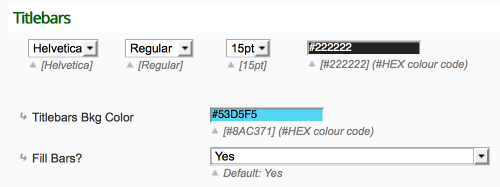
- If you choose a dark background color, try white (#FFFFFF) as the text color
Edit PDF Column Titles
There's options inside the config for each page to set the text which shows at the top of each PDF column.
Just edit and save.
You an also change the position across the page while you're there ('X-Pos').
Add Admin and Customer Comments
If your customer is entering messages (eg. in checkout) or you are adding order comments, you can show these in the PDFs.
If you're writing admin-only viewable messages (eg. "This customer sucks!") make sure you select Show only notes tagged 'Visible in Frontend' ...
Show Gift Messages
pickPack is setup to show order- or product-level gift messages.
You can set them to show:
- under each product (for product-level gift messages),
- under the products list, or even
- in a movable box (handy if you're printing into an integrated label and need to line up the messages onto a sticker to be put into a gift card)
- If setting this option, you can also set:
- * the max width of the message box (to fit everything into a sticker)
- * the specific position of the to/from titles
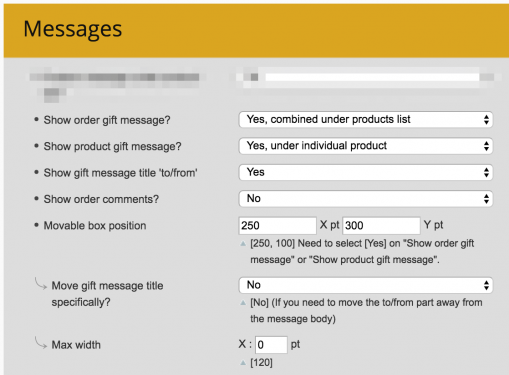
Add a Custom Message
You can add a custom message (e.g. 'Thank You', return instructions, company address, coupon code) to your PDFs. This can be set per store (by changing the config scope).
- Set Messages > Custom message under product list? to Yes
- Note that this option is under the 'Custom message under product list option', and not the others
Change the Background Colors and Fonts of Messages
Just go to the General config section for Messages and look for this:
Changing Font Size/Colour in PDFs
- Head to the General section and you'll see a lot of different options.
- To set the Shipping Address & Return Address font sizes, you will find those next to the specific config sections to turn those on/off.
Français/Deutsch/Español/etc : Translations
- Open /app/locale/en_US/Moogento_PickPack.csv
- (choose your language pair instead of en_US, eg. fr_FR for French)
- Find the text that you want to translate, eg.
"Tax Label","Tax" - If the words to translate are already there, and what you want to replace them with is unique to you, add the line, with your changes, to your /app/locale/en_US/translate.csv file to ensure that your changes aren't overwritten in the next update from us.
- (replace 'en_US' with your language pair, eg. nl_NL for Dutch)
- If you spot an incorrect or missing translation, please send it to us and we'll add it to the next release, meanwhile add the changes to your translate.csv file.
- Clear the cache and your changes should come through.
Showing 中国/日本の/한국의/русский in PDFs
If you're printing non-Roman characters (ie. accented letters, or picture scripts) in your PDFs you'll need to setup a different font in the config.
pickPack will then attach a font file with the PDF which will then be able to show those characters at the other end.
- Set General > Seeing tofu : ▯? to Yes
This will use a larger font family with more characters in it, which is likely to sort the 'tofu'.
(The 'tofu' is basically characters that aren't in the font which is attached to the PDF or available to your local system)
If you still see tofu then :
- Set General > Customise fonts/colours? to Yes
- Choose a specific font to suit the characters you're trying to output
- For these custom fonts, you need to install the optional font pack, which you can find in your Downloads page at Moogento.
- (You need to be on a current pickPack license to have access to that)
- (You need to be on a current pickPack license to have access to that)
Address Labels
Print a sheet with all shipping addresses.
- Add in order ID barcodes, return addresses.
- Customize label padding and margins to suit your label sheets.
- NB. pickPack prints addresses in this order:
[1][5]
[2][6]
[3][7]
[4]
"How Do I Make an A4 Sheet with 15 Address Labels (3 wide x 5 high)?"
- Head to the SystemConfigpickPack -> PDF Address-label Sheet
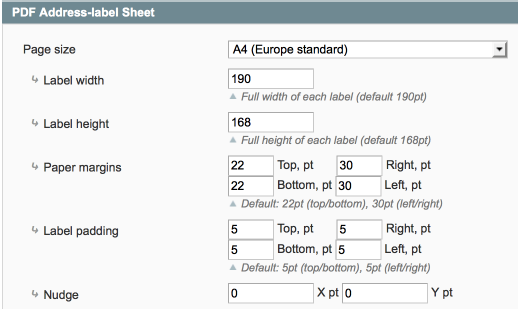
- Let's assume that we're printing on A4-size paper (just adjust dimensions if using Letter-size)
- A4 is 595 x 842pt, but we have some page margins so that our printer can print everything, a good standard is 10pt top/bottom, and 1pt left/right.
- So our new printable area is (595 - 10 - 10) x (842 - 1 - 1) = 575 x 840.
- So if we're printing on a standard address label sheet, of 3 labels wide x 5 labels high, then, or (575/3=)190 x (840/5=)168 per label. So, we can set that in the config (Label width / Label height). This will be the size that we print the address into, and we'll be trimming or word-wrapping address lines to match this.
- If we want some padding in the label, so that we don't print right up to the edge of the label (to make it look a bit better), we can then add in some 'Label padding'. A good start is 5pt here.
- Try a test print. You can change the size of the labels to match your print media, and use the 'Nudge' options to nudge the labels about inside the allotted space.
- Pro-tip: you can add in the order ID as a barcode (and as the actual numbers) and nudge those to fit available space in your labels.
Warehouse/Shipping Printouts
pickPack has a wide range of PDF and CSV outputs available, to integrate Magento with your packing setup - whether that's a large warehouse, or your garage! These are all fairly self-explanatory to setup, but quick overviews follow.
- On the PDFs, you can show up to two tickboxes per line item (handy for packing and checking).
- You can also set it to show the product SKUs as barcodes.
PDF Order-Combined Picklists
These are a great way to get the sum total of what has been ordered for a select group of orders.
- In the config section you can choose to show the total-cost/total-paid/total-shipping.
- This can be useful to work out profit/loss on a group of orders.
- Alternatively if you are dropshipping, or purchasing these items from outside suppliers, you can work out what you'll need to pay them.
Show custom product attributes in picklist
You can show up to 4 custom product attributes:
If it makes sense to compress the space they take up in the picklist, you can set Yes for 'Combine attributes', which will put them net to each other (instead of separate columns).
Show custom product options in picklist
You can also show custom product options in the combined picklist output.
{{idea|If your warehoused products are stored in a way where each custom option is a different product, you probably want to choose :
- Yes, count each option as a separate SKU, grouped under parent product
PDF Order-Separated Picklists
A nice simple way to get an overview of what has been ordered, what needs picking, shipping method chosen, etc.
- In the config section you can turn on order ID and product barcodes, shipping addresses and methods, and show extra product attributes.
- You can also set it to show out of stock items.
PDF Orders Summary
Similar to the Order-Separated Picklist, this can also show totals paid for each order, including taxable and zero-rated totals.
- You can also add barcodes, so at the end of the day you can quickly reselect relevant orders for further processing with shipEasy.
- This is useful for entering orders into accounts.
PDF Out-of-Stock Picklists
If you're buying in products from outside suppliers, or need a quick overview of which items need ordering from the factory, this will show a list of only those items which are out-of-stock in selected orders.
- You can set what qty to consider out of stock.
- You can configure it to show a custom attribute (eg. shelf).
Print Product Attributes as Barcodes
You can quickly edit incoming stock using stockEasy and a barcode scanner.
You can also add these to most PDF outputs, and can choose which product attribute to print as the barcode. How you use that printed barcode is up to you (it probably won't help with stockEasy and that kind of printout as the stock levels will already have been edited inside Magento).
Don't have barcodes for your products?
What you make as the barcode depends on what you're going to use the barcodes for.
- If it's just for your own use then you can make them whatever you want.
- Product Sku might be a good one.
- If the barcode could be scanned elsewhere (eg. if you're selling goods that you're manufacturing and they might be scanned inside a retail store) then you'll likely want to assign a unique GTIN or ASIN code to each product. These are onetime-use codes, and you can buy these from the official authority for such things in your country.
CSV Exports
These are very powerful, very customisable, but also very simple-to-setup options.
Edit the CSV Export
In the General section, you can edit a few CSV output options.
Changing the Field Separator Character
ie. Which character is used to separate fields:

"Quoting" All Values
If you're seeing mangled output in spreadsheets, you might want to set this:

Strip Linebreaks
Specifically from non-address fields. (We don't change the address fields as you can set the format of that in the config)
If you're seeing occasional entries like ,, in your spreadsheet, it could be from linebreaks messing with your spreadsheet import logic.
Set this and see the win!
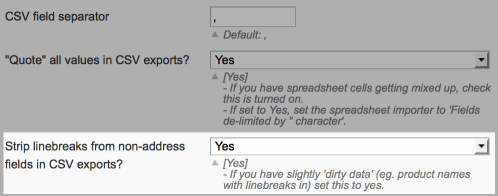
CSV Orders Export
- This will output one line per selected order, in a CSV file.
- You can include order summary info in this csv, such as:
- Shipping/billing addresses
- Customer name (and the parts if needed)
- Amount paid
- Date of order
Format
- Enter into the large text box one line per column which you'd like to generate in the CSV.
- Use this format:
Column Name 1:%magento_order_attribute_here%;
- This will have a column title of 'Column Name 1' and will show values from the magento order attribute
magento_order_attribute_here.
Column Name 2:[fixed text here];
- This will have a column title of 'Column Name 2' and will have in every cell
fixed text here.
Column Name 3:%magento_order_attribute_here% %another_magento_order_attribute_here%;
- This will have a column title of 'Column Name 3' and will show combined values from the magento order attributes
magento_order_attribute_hereandanother_magento_order_attribute_here.
- For the 'magento order attribute', use one of the options from the list below.
%ship-address%and%bill-address%are slightly special, they combine the entire address into one field, and you can set the order and contents of the address particles in the separate options box for that.
Options
- Order Info
%order_id%
%order_status%
%order_subtotal%
%order_tax_amount%
%warehouse%
%grand_total%
%order_date%
%qty_items%
%website%
%customer_id%
%newsletter_subscription_status%
- Order Weight
%weight% : total weight as entered (eg '120')
%weight_kg_suffix% : total weight with 'kg' text suffixed (eg '120 kg')
%weight_lb_suffix% : total weight with 'lb' text suffixed (eg '120 lb')
%weight_kg_to_lb% : total weight converted from kg to lb (eg '264.55')
%weight_lb_to_kg% : total weight converted from lb to kg (eg '54.43')
%weight_kg_to_lb_suffix% : total weight converted from kg to lb
with 'lb' text suffixed (eg '264.55 lb')
%weight_lb_to_kg_suffix% : total weight converted from lb to kg
with 'kg' text suffixed (eg '54.43 kg')
- Billing Info
%bill_address%
%bill_prefix%
%bill_firstname%
%bill_lastname%
%bill_suffix%
%bill_fullname%
%bill_company%
%bill_streets%
%bill_street1%
%bill_street2%
%bill_city%
%bill_region%
%bill_postcode%
%bill_country%
%bill_country_code%
%bill_telephone%
%bill_email%
%payment_method%
- Shipping Info
%ship_address%
%ship_prefix%
%ship_firstname%
%ship_lastname%
%ship_suffix%
%ship_fullname%
%ship_company%
%ship_streets%
%ship_street1%
%ship_street2%
%ship_city%
%ship_region%
%ship_postcode%
%ship_country%
%ship_country_code%
%ship_telephone%
%ship_email%
%ship_method%
%shipping_paid%
- Special Info
%shipping_description_filtered%
%ship_service_filtered%
%billing_option_filtered%
%bill_non_us%
%ship_non_us%
CSV Order-Separated Export
- This will output one line per ordered SKU per selected order in a CSV file.
- eg. same sku ordered in 2 orders will appear on two lines.
- You can include product details and some order info in this csv, such as:
- Shipping/billing addresses
- Customer name (and the parts if needed)
- Amount paid
- Date of order
- Price of item
- SKU, product name, options chosen
- Gift messages
Format
- Enter into the large text box one line per column which you'd like to generate in the CSV.
- Use this format:
Column Name 1:magento_standard_product_attribute;
- This will have a column title of 'Column Name 1' and will show values from the magento product attribute
magento_standard_product_attribute. - eg. color, size, your_custom_product_attribute.
Column Name 2:[fixed text here];
- This will have a column title of 'Column Name 2' and will have in every cell
fixed text here.
Column Name 3:%magento_special_attribute%;
- This will have a column title of 'Column Name 3' and will show the value from the 'special' order attributes
magento_special_attribute.
- For the 'magento special attribute', choose from from the Options list below.
Options
- Order Info
%order_id%
%order_date%
%order_date_plus48h%
%website%
%order_subtotal%
%order_status%
%order_tax_amount%
%order_price%
%order_qty%
%comment%
- Customer Details
%customer_id%
%bill-firstname%
%bill-lastname%
%bill-companyname%
%bill-street1%
%bill-street2%
%bill-city%
%bill-region%
%bill-postcode%
%bill-country%
%bill-non-us%
%bill-telephone%
%bill-email%
%ship-firstname%
%ship-lastname%
%ship-companyname%
%ship-street1%
%ship-street2%
%ship-city%
%ship-region%
%ship-postcode%
%ship-country%
%ship-non-us%
%ship-telephone%
%ship-email%
%shipping_address%
- Product Details
%sku%
%qty%
%product_name%
%sku_price%
%total_price%
%unit_price%
%short_description%
%product_description%
%description%
%gift_messages%
CSV Order-Combined Export
- This will output one line per unique SKU from all selected orders, in a CSV file.
- eg. same sku ordered in 2 orders will appear on one lines.
- You can include product details in this csv, such as:
- Cost of item
- SKU, product name, options chosen
Format
- Enter into the large text box one line per column which you'd like to generate in the CSV.
- Use this format:
Column Name 1:magento_standard_product_attribute;
- This will have a column title of 'Column Name 1' and will show values from the magento product attribute
magento_standard_product_attribute. - eg. color, size, your_custom_product_attribute.
Column Name 2:[fixed text here];
- This will have a column title of 'Column Name 2' and will have in every cell
fixed text here.
Column Name 3:%magento_special_attribute%;
- This will have a column title of 'Column Name 3' and will show the value from the 'special' order attributes
magento_special_attribute.
- For the 'magento special attribute', choose from from the Options list below.
Options
- Product Details
%sku%
%qty%
%product_name%
%average_unit_cost%
%total_cost%
%unit_price%
%total_price%
%short_description%
%product_description%
%description%
%product_category%
Change Filename Format
By default files save with the current date as the filename, prefixed by the type of output (eg. 'packing_sheet_2015_02_23.pdf').
This works well for the majority of filing systems, as an easy way to see past prints, but you may want to sort by Order ID.
In this case, we can add that Order ID to the filename - head to the General section and look for this:
This will only work if you print individual orders - multiple-order prints will just save the date.









